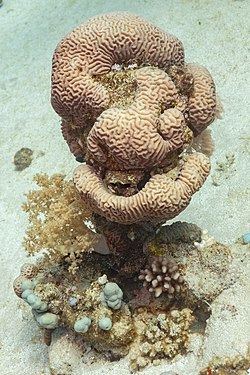| Platygyra daedalea | |
|---|---|
 | |
| P. daedalea from Ras Muhammad National Park, Egypt | |
| Scientific classification | |
| Kingdom: | Animalia |
| Phylum: | Cnidaria |
| Subphylum: | Anthozoa |
| Class: | Hexacorallia |
| Order: | Scleractinia |
| Family: | Merulinidae |
| Genus: | Platygyra |
| Species: | P. daedalea |
| Binomial name | |
| Platygyra daedalea (Ellis & Solander, 1786) [2] | |
| Synonyms [2] | |
List
| |
Platygyra daedalea, sometimes known as the lesser valley coral, is a colonial species of stony coral in the family Merulinidae. It occurs on reefs in shallow water in the Indo-Pacific region. It is a common species and the International Union for Conservation of Nature has assessed its conservation status as being of "least concern". [1]

